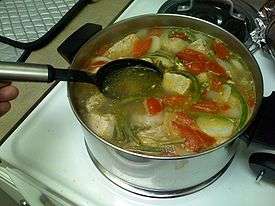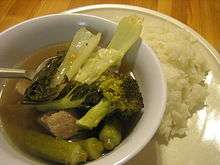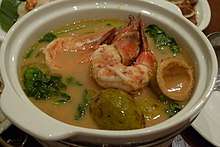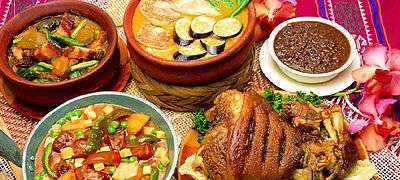Sinigang
Sinigang is a Filipino soup or stew characterized by its sour and savoury taste. It is most often associated with tamarind (Filipino: sampalok), although it can use other sour fruits and leaves as the souring agent. It is one of the more popular dishes in Filipino cuisine.
 A pot of tamarind sinigang | |
| Type | Soup or stew |
|---|---|
| Course | Main course |
| Place of origin | Philippines |
| Serving temperature | Hot |
| Main ingredients | Meat, vegetables, tamarind, fish sauce, onions, siling mahaba, tomatoes |
| Variations | Pork, beef, shrimp, fish, chicken |
| Similar dishes | Pinangat na isda, paksiw |
| Other information | Can be served in many different forms |
Origin
Sinigang means "stewed [dish]", it is a nominalized form of the Tagalog verb sigang, "to stew".[1] While present nationwide, sinigang is seen to be culturally Tagalog in origin, thus the similar sour stews and soups found in the Visayas and Mindanao (like linarang) are regarded as different dishes and differ in the ingredients used. Fish sauce is a common condiment for the stew. The Malaysian dish singgang is derived from sinigang.[2]
Ingredients

Sinigang is most often associated with tamarind in modern times, but it originally referred to any meat or seafood cooked in a sour and acidic broth, similar to but differentiated from paksiw (which uses vinegar).[2] Other variations of the dish derive their sourness from native ingredients. These souring agents include unripe mangoes, butterfly tree leaves (alibangbang), citruses (including the native calamansi and biasong), santol, bilimbi (kamias or iba), gooseberry tree fruits (karmay), binukaw fruits (also batuan), and libas fruits, among others.[3][4] Guava, introduced to the Philippines via the Manila galleons is also used.[5] Seasoning powder or bouillon cubes with a tamarind base are commercial alternatives to using natural fruits.[6][7]
Sinigang typically use meat or seafood (e.g., fish, pork, beef, shrimp, or chicken) stewed with tamarind, tomatoes, garlic, and onions. Other vegetables commonly used in the making of sinigang include okra, taro corms (gabi), white radish (labanós), water spinach (kangkóng), yardlong beans (sitaw) and eggplant (talóng). Most Filipinos like to cook sinigang with green long peppers in order to enhance the taste and add a little spice to the dish. Another variation includes adding locally made miso.
Sinigang variations

- Sinigáng sa misô - Sinigang with miso added to the soup as the umami element, usually with a tamarind base
- Sinigáng sa bayabas - Sinigang that uses guava as the sour soup base
- Sinigang sa mangga - Sinigang that uses unripe mango as the sour soup base
- Sinigang sa kalamansi - Sinigang that uses calamansi or lemon as the sour soup base
- Sinigáng na isdâ - Fish sinigang
- Sinigáng na baboy - Pork sinigang
- Sinigáng na hipon - Shrimp or Prawn sinigang [8]
- Sinigang na baka - Beef sinigang
- Seafood sinigang - Fish, shrimp, squid, sea shells are combined in this soup [9]
- Bule baluga - A variant of sinigang from the Aeta people of Pampanga that uses lima beans (bule) and is soured with alibangbang (butterfly tree) leaves. The name is controversial as baluga is considered derogatory to the Aeta.[10][11]
Similar dishes
Sinampalukang manók or sinampalukan is technically not a variation of sinigang, as the chicken has to be sautéed in ginger first instead of all the ingredients being placed simultaneously into the pot and brought to a boil. Sinampalukan is also distinguished by its use of shredded tamarind leaves, and is usually made together with ginger, onions, tomatoes, eggplant and other vegetables.[12][13]
Other Filipino dishes that are similar to sinigang but distinct include pinangat na isda from Southern Luzon and linarang from Cebu. Both of which also use sour fruits but are restricted to fish or seafood and differ in the other ingredients used.[14][15][16]
References
- "sigang". Tagalog-Dictionary.com. Retrieved 16 December 2018.
- Pamaran, Maan D'Asis (12 October 2016). "The Filipino-Spanish food connection". Philippine Daily Inquirer. Retrieved 16 December 2018.
- "The Souring Agents of Sinigang". Our Philippine Trees. Retrieved 17 April 2019.
- "Sinigang na Salmon at Bauhinia Filipino Cuisine". Flavours of Iloilo. Retrieved 17 April 2019.
- The Souring Agents of Sinigang
- Sinigang Recipe
- Sinigang na Baboy Recipe
- Sinigang na Hipon Recipe - Pinoy Recipe at Iba pa. Retrieved March 30, 2019
- Seafood Sinigang Recipe - Pinoy Recipe at Iba pa. Retrieved March 30, 2019
- "Bule". Steamy Bain Marie. Retrieved 29 November 2019.
- Daez, Mikael (3 November 2013). "Saksi: Bule baluga, sinigang na pinasarap ng patani". Saksi (in English and Tagalog). GMA. Retrieved 29 November 2019.
- Manalo, Lalaine. "Sinampalukang Manok". Kawaling Pinoy. Retrieved 13 April 2019.
- "Sinampalukan Manok (Tamarind'd Chicken)". 80 Breakfasts. Retrieved 13 April 2019.
- "Pinangat na Isda Fish Poached in Kamias and Tomatoes". Filipino-food-recipes.com. Retrieved 10 January 2019.
- Belen, Jun. "How to Make Fish Pinangat (Fish Soured in Calamansi and Tomatoes)". Junblog. Retrieved 10 January 2019.
- Fenix, Michaela (2017). Country Cooking: Philippine Regional Cuisines. Anvil Publishing, Incorporated. ISBN 9789712730443.
Further reading
| Wikibooks Cookbook has a recipe/module on |
- Eckhardt, Robyn and David Hagerman. (2007-02-15). Why Not Sinigang?. Retrieved 2010-08-02 from the EatingAsia food blog.
- Fernandez, Doreen. (1976). Why Sinigang?. In Gilda Cordero-Fernando. The Culinary Culture of the Philippines. Manila: Bancom Audiovision Corporation. pp. 24–29.
- Perez, Irene C. (2010-07-01). Why piping-hot ‘sinigang’ is the national dish. Philippine Daily Inquirer. Retrieved 2010-08-02.
.jpg)
